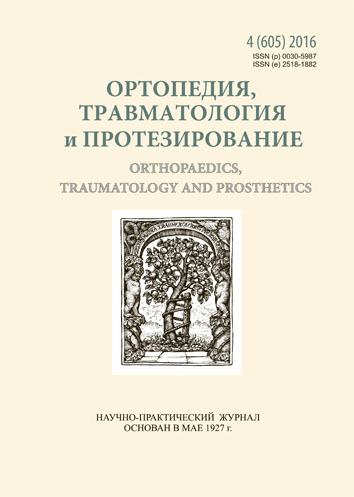Role of surgical treatment methods in medical rehabilitation for patients with deceases and consequences of muscle-skeletal injuries
DOI:
https://doi.org/10.15674/0030-59872016490-95Keywords:
replacement arthroplasty, arthroplasty, arthrodesis, rehabilitationAbstract
Objective: to show the effectiveness of modern methods of treatment in the rehabilitation of patients with different diseases and injuries terms in the department of orthopedics, arthrology and sports injuries.
Methods: we analyzed 1974 medical records of patients who treated during the period from 2013 to 2015. Surgery was performed in 1 655 patients, of which 69.5 % had disruption of musculoskeletal deseases, 29.3 % — injuries, 1.2 % — mixed genesis (osteoporotic fractures, fibrous dysplasia, etc.). Cement and cementless arthroplasty of local and foreign production and invasive (arthroscopic) surgery were performed. Recurrent physiccal rehabilitation treatment had 319 patients.
Results: knee replacement performed in 105 patients, hip replacement in 333, arthroscopy in 1 129. Operations on the lower limbs accounted for 96 %, including 86 % — minimally invasive arthroscopic (refixation and plastics of knee-ligament apparatus and ankle joints). Hospital stay was less than 6 days in 205 patients. After arthroscopic operations on the knee, patients began loading on the first day without crutches, under the supervision of a practitioner-rehabilitation. Most patients (76.2 %) with injuries knee joint were in working age, 21 to 50 years. Among those aged 51 to 70 years and older with diseases of the joints in the main and control group dominated by women. Modern methods of diagnosis and surgical treatment, early rehabilitation helped to reduce the time of treatment and patients return to full activity.References
- Agajanyan VV. Recovery of motor function in patients with pathology of hip by arthroplasty technique. Traumatology and Orthopedics of Russia. 2002;(1):24-7. (in Russian)
- Buylova TV. Evaluation of clinical and functional status of patients with degenerative-dystrophic diseases of hip joint during the rehabilitation process: The thesis on a scientific degree of PhD in medical sci. Nizhny Novgorod, 2004. 46 р. (in Russian)
- Golovakha ML, Banit OV, Titorchuk RV, et al. The results of the restoration of complex lesions of ligament apparatus of the knee joint. Orthopaedics, traumalogy and prosthetics. 2015;(3):76-86. doi: 10.15674 / 0030-59872015378-86. (in Russian)
- Kolesnikov MA. Treatment of gonarthrosis: the modern principles and approaches. Practical Medicine. 2010;47:97-9. (in Russian)
- Kuzmin AM, Kirpichev IV. Quality of life in patients with consequences fracture of the femoral neck. Modern problems of science and education, 2011;(6):21. (in Russian)
- Ivanchin DM, Vasiliev TM, Petrov KB. Features rehabilitation of patients after hip arthroplasty [web source]. Access: http://www.medlinks.ru/ article.php?sid=37142. 2009.
- Mashkov VM. Surgical treatment of dysplastic coxarthrosis in adult. Questions of social and medical rehabilitation of patients with dressing care companies and diseases of the musculoskeletal system. Leningrad, 1990. рр. 135-8. (in Russian)
- Smirnov AV. Atlas radiological diagnosis of primary osteoarthritis. Moskow, 2010. 22 p. (in Russian)
- Brander V, Stulberg S. Rehabilitation after hip- and knee-joint replacement. An experience- and evidence — based approach to care. Am J Phys Med Rehabil. 2006;85(11):S98–S118. doi: 10.1097/01. phm.0000245569.70723.9d
Downloads
How to Cite
Issue
Section
License
Copyright (c) 2017 Anatoly Kudievskye, Maksim Golovakha, Igor Shishka, Ivan Zabielin, Evgeniy Zavdun

This work is licensed under a Creative Commons Attribution 4.0 International License.
The authors retain the right of authorship of their manuscript and pass the journal the right of the first publication of this article, which automatically become available from the date of publication under the terms of Creative Commons Attribution License, which allows others to freely distribute the published manuscript with mandatory linking to authors of the original research and the first publication of this one in this journal.
Authors have the right to enter into a separate supplemental agreement on the additional non-exclusive distribution of manuscript in the form in which it was published by the journal (i.e. to put work in electronic storage of an institution or publish as a part of the book) while maintaining the reference to the first publication of the manuscript in this journal.
The editorial policy of the journal allows authors and encourages manuscript accommodation online (i.e. in storage of an institution or on the personal websites) as before submission of the manuscript to the editorial office, and during its editorial processing because it contributes to productive scientific discussion and positively affects the efficiency and dynamics of the published manuscript citation (see The Effect of Open Access).














